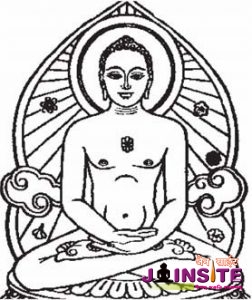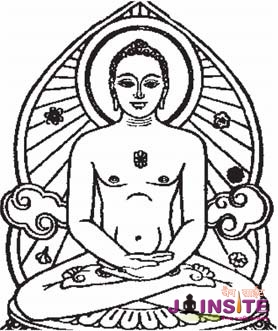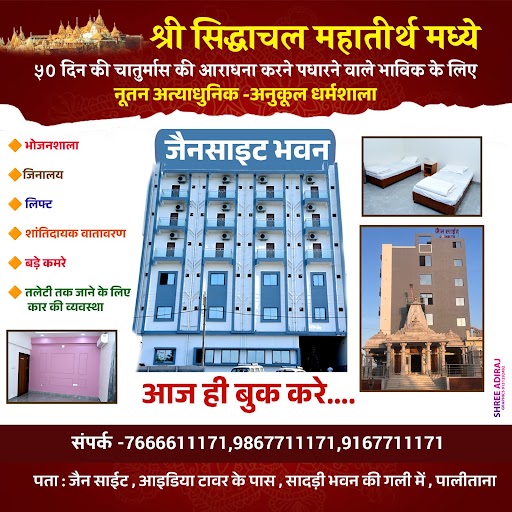Chapter 02 – Tirthankars
Time rolls along in eternal cycles of rise and decline. Utsarpini is a “rising” era in, which human morale and natural conditions improve over time. At the end of Utsarpini, begins Avasarpini, a “declining” era of the same length, in, which human morale and virtues deteriorate. Each era consists of six sub divisions called Äräs. During the 3rd and 4th Äräs of every rising and declining era of each cycle, twenty-four souls become Tirthankars in our region known as Bharat Kshetra. They are the humans like us who rise to that level. They had gradually purified their soul in prior lives after achieving Samyag Darshan and had acquired a special karma called Tirthankar Näm Karma. The Tirthankar Näm Karma is acquired by performing one or more of the 20 specific austerities.
Tirthankar Näm Karma matures in the final life and leads the person to become a Tirthankar after taking Dikshä and observing austerities to destroy all Ghäti (destructive) karmas. After attaining omniscience (Kevaljnän), Tirthankar organizes the Jain religion to suit the changing times. They reinstate the fourfold order of Sädhus (monks), Sädhvis (nuns), Shrävaks (male householders), and Shrävikäs (female householders) of Jain religion.
Tirthankars are also called Arihantas, Jinas, Kevalis, and Vitarägi. Arihanta means “destroyer of inner enemies,” Jin means “victor of inner enemies,” and Vitarägi means “one who does not have attachment or hatred towards anyone or anything.” This means that they are totally detached from worldly aspects. They have destroyed four Ghäti Karmas, namely:
- Jnänävaraniya (knowledge obscuring) Karma
- Darshanävaraniya (perception obscuring) Karma
- Mohaniya (deluding) Karma
- Antaräya (obstructing) Karma
Kalyänak (Auspicious Events)
Jains celebrate five major events from the life of a Tirthankar. They are called Kalyänak (auspicious events). They are:
Chyavana or Garbha Kalyänak – (Conception Event)
This is the event when a Tirthankar’s soul leaves its previous body, and is conceived in the mother’s womb.
Janma Kalyänak – (Birth Event)
This is the event when the Tirthankar is born.
Dikshä or Tapa Kalyänak – (Initiation Event)
This is the event when the Tirthankar gives up all his/her worldly possessions and becomes a monk/nun.
Kevaljnän Kalyänak – (Omniscience Event)
This is the event when a Tirthankar completely destroys four Ghäti Karmas and attains the Kevaljnän (absolute knowledge). Celestial angels create a Samavasaran for
Tirthankars from where he/she delivers the first sermon. This is the most important event for the entire Jain order as the Tirthankar re-establishes Jain Sangha and preaches the Jain path of purification and liberation.
Nirvän Kalyänak – (Nirvana Event)
This event is when a Tirthankar’s soul is liberated from this worldly physical existence forever and becomes a Siddha. On this day, the Tirthankar’s soul destroys the remaining four Aghäti Karmas completely, and attains salvation, the state of eternal bliss.
Digambar tradition indicates that women cannot become Tirthankar or be liberated because they need to cover their body with cloths after the renunciation (after becoming nuns). Hence they cannot follow the fifth Mahävrata (Non-possession) fully. For liberation, it is essential that all five Mahävrata be followed fully. Swetambar tradition interprets the fifth Mahävrata as Non-possessiveness indicating that monks and nuns may need to wear the minimum cloths needed to properly function their daily activities in the society (e.g. Gochari – Going to laypeople home for food). However they should not have any attachments to their cloths.
Number of Tirthankars :
It was stated earlier that Tirthankars are born only in 3rd and 4th Äräs in our region called Bharat Kshetra of Jambu Dweep. Since we are in the 5th Ärä now, no Tirthankar exist in our region. In the 3rd and 4th Äräs of current Avasarpini cycle, the twenty-four Tirthankars were borne in our region. Generally, we state that there are twenty-four Tirthankars, we specifically mean that there were twenty-four Tirthankars in the 3rd and 4th Arä of the current Avasarpini time cycle.
According to Jainism, there are 15 regions in the universe whrer the possibility of Tirthankars exist. Out of these, 10 regions (5 Bharat and 5 Airävat) are such that the human behavior and natural conditions continuously changes and Tirthankars appear only during 3rd and 4th Äräs.
The other five regions (5 Mahä-Videha) are such that the conditions are always conducive to have Tirthankar. At present, there exist four Tirthankars in each Mahä-Videha Kshetra (regions). Thus, there are a total of 20 Tirthankars preaching Jainism in Mahä-Videha regions at present time. Shri Simandhar Swami is one of the 20 Tirthankars. In many Jain temples, an idol of Shri Simandhar Swami is installed which represents and reminds us that at present there are living Tirthankars preaching Jainism in the other part of the universe. This is also important since a soul can transmigrate to and take a human birth in one of the Mahä-Videha regions now and progress to reach liberation even though it is not possible to attain liberation in the present time in our region (Bharat Kshetra).
Past and Future Tirthankars :
There were also twenty-four Tirthankars (Chovisi) in our region in the past Utsarpini half cycle of time. There will also be twenty-four Tirthankars in the next Utsarpini half cycle. The names of both are found in our scriptures. There have been infinite such chovisis in our Bharat Kshetra as well as Airavat Kshetra. Therefore when we state that there are twenty-four Tirthankars, we must remember that our statement applies only to our current Avasarpini cycle. In reality, there have been infinite number of Tirthankars existed in the past in our region and hence
infinite Siddhas.
Tirthankar Stutis :
There exist many Stutis praising the qualities of Tirthankars in Jain literature. Following is the list of some popular Stutis.
• Logassa Ujjoyagare (Chaturvishati Stav) Sutra – This sutra is recited in praise of the twenty-four Tirthankars. It consists of names of each Tirthankar and their qualities.
• Namutthunam (Shakra Stav) Sutra – This sutra is sung by Indra the king of Celestial
Beings in the praise of Arihantas (present and past). In this stuti, only their virtues are stated without any specific names.
• Bhaktämar Stotra – This is most popular Stotra and is accepted by both Digambar and
Shvetämbar Jain sects. This was composed by Ächärya Manatung-suri in praise of
Tirthankar Rishabhadev.
• Anandghana Chovisi – Jain monk Shri Anandghanji who was a great poet has composed
24 Stutis (one stuti for each Tirthankar) in praise of twenty-four Tirthankars.
Role of Celestial Beings :
There are other significant events also in the life of a Tirthankar. After Tirthankar’s soul is conceived, the mother has fourteen dreams as per Shvetämbar tradition (Digambar texts mention two additional dreams making the total to sixteen). A Tirthankar’s soul, while even in mother’s womb, possesses three types of knowledge, namely Mati Jnän (sensory knowledge), Shruta Jnän (scriptural knowledge), and Avadhi Jnän (clairvoyance). Celestial beings (Indras and other heavenly beings) are devoted to Tirthankars and take part in ceremonies like birth and the bathing of newborn on Mount Meru.
One year before the time of renunciation, a group of celestial angles come to pay homage to the future Tirthankar. They remind him/her to renounce the world and re-establish religious order for the benefit of all living beings. When a Tirthankar renounces the worldly life, he attains Manah-Paryäya Jnän (telepathy), the fourth type of the knowledge, which enables the Tirthankar to read the minds of other living beings. Celestial beings also participate in the celebrations of other Kalyänaks and for setting up 8 Pratihärya during sermons given by Tirthankar.
Conclusion
 There are five very auspicious events in the life of a Tirthankar. They are conception, birth, renunciation (initiation into monkhood), attaining omniscience, and nirvana. A Tirthankar has acquired the Tirthankar-Näm Karma in the second previous life by having an intense desire to alleviate the suffering of all living beings. The fruits of that karma resulted in the soul being born as a Tirthankar Bhagawän. We celebrate these five major events of the Tirthankar’s life in the form of Pancha- Kalyänak Pujäs. The nirvana places of Tirthankars are pilgrimage places. Tirthankars are supreme human beings and our faultless human models in whom we take spiritual refuge.
There are five very auspicious events in the life of a Tirthankar. They are conception, birth, renunciation (initiation into monkhood), attaining omniscience, and nirvana. A Tirthankar has acquired the Tirthankar-Näm Karma in the second previous life by having an intense desire to alleviate the suffering of all living beings. The fruits of that karma resulted in the soul being born as a Tirthankar Bhagawän. We celebrate these five major events of the Tirthankar’s life in the form of Pancha- Kalyänak Pujäs. The nirvana places of Tirthankars are pilgrimage places. Tirthankars are supreme human beings and our faultless human models in whom we take spiritual refuge.
Emblems and Place of Nirvän of 24 Tirthankars :
| Tirthankar Name | Emblem | Number of Ganadhars* |
| 01 Rishabha or Adi Nath | Bull | 84 |
| 02 Ajit-Nath | Elephant | 90 |
| 03 Sambhava-Nath | Horse | 105 |
| 04 Abhinandan Swami | Monkey | 103 |
| 05 Sumati-Nath | Ruddy Goose | 116 |
| 06 Padma-Prabha | Red Lotus | 111 |
| 07 Suparshva-Nath | Swastika | 95 |
| 08 Chandra-Prabha | Crescent Moon | 93 |
| 09 Pushpadanta or Suvidhi-Nath | Crocodile | 88 |
| 10 Shital-Nath | Shrivatsa or wishing tree | 81 |
| 11 Shreyans-Nath | Rhinoceros | 77 |
| 12 Vasupujya Swami | Buffalo | 66 |
| 13 Vimal-Nath | Boar | 55 |
| 14 Anant-Nath | Bear or hawk | 50 |
| 15 Dharma-Nath | Thunderbolt | 43 |
| 16 Shanti-Nath | Deer | 36 |
| 17 Kunthu-Nath | Male Goat | 35 |
| 18 Ara Nath | Nandavarta or Fish | 30 |
| 19 Malli-Nath | Water Pot | 28 |
| 20 Muni Suvrata Swami | Tortoise | 18 |
| 21 Nami Nath | Blue Lotus | 17 |
| 22 Nemi-Nath | Conch | 11 |
| 23 Parshva Nath | Serpent | 10 |
| 24 Mahavir Swami or Vardhaman
|
Lion | 11 |
Mahävir Swami attained nirvana at Päväpuri, Nemi-Näth attained nirvana at Girnar, Väsupujya attained nirvana at Champäpuri,
Rushabhdev attained nirvana at Mount Ashtäpad (Kailäsha).
Other Twenty Tirthankars attained nirvana at mount Samet Shikhar.
*Ganadhars are the chief disciples of the Tirthankars.
Birth Place and Parents Name of 24 Tirthankars :
| Tirthankar Name | Father | Mother |
| 01 Rishabha or Adi Nath | King Nabhi | Maru-Devi |
| 02 Ajit-Nath | Jita Shatru | Vijay |
| 03 Sambhava-Nath | Nath Jitari | Sena |
| 04 Abhinandan Swami | Samvar | Siddhartha |
| 05 Sumati-Nath | Megharath | Sumangala |
| 06 Padma Prabha | Dharana (Sridhara) | Susima |
| 07 Suparshva-Nath | Supratishta | Prithvi |
| 08 Chandra Prabha | Mahasen | Lakshman |
| 09 Pushpadanta or Suvidhi-Nath Nath | Sugriva | Rama (Supriya) |
| 10 Shital-Nath | Draidharatha | Sunanda |
| 11 Shreyans-Nath | Vishnu | Vishnudevi (Vishna) |
| 12 Vasupujya Swami | King Vasu | Vijaya (Jaya) |
| 13 Vimal Nath | Kritvarma | Suramya (Shyama) |
| 14 Anant Nath | Simhasen | Suyasha |
| 15 Dharma Nath | King Bhanu | Suvrata |
| 16 Shanti-Nath | Vishvasen | Achira |
| 17 Kunthu-Nath | Surya (Surasen) | Shree-Devi |
| 18 Ara-Nath | Sudarshan | Mitra (Devi) |
| 19 Malli Nath | Kumbha | Rakshita (Prabha) |
| 20 Muni Suvrata Swami | Sumitra | Padmavati |
| 21 Nami Nath | Vijay | Vapra (Vipra) |
| 22 Nemi Nath | Samudravijay | Shivadevi |
| 23 Parshva Nath | Ashvasen | Vama |
| 24 Mahavir Swami or Vardhaman | Siddhartha | Trishala |
Place of Nirvan and Birth Place of 24 Tirthankars :
| Tirthankar Name | Place of Nirvan | Birth Place |
| 01 Rishabha or Adi Nath | Ashtapad (Kailasha) | Ayodhya |
| 02 Ajit-Nath | Samet Sikhar | Ayodhya (Vinita) |
| 03 Sambhava-Nath | Samet Sikhar | Shravasti |
| 04 Abhinandan Swami | Samet Sikhar | Ayodhya (Vinita) |
| 05 Sumati-Nath | Samet Sikhar | Ayodhya |
| 06 Padma Prabha | Samet Sikhar | Kaushambi |
| 07 Suparshva-Nath | Samet Sikhar | Varanasi (Banaras) |
| 08 Chandra Prabha | Samet Sikhar | Chandrapuri |
| 09 Pushpadanta or Suvidhi Nath Nath | Samet Sikhar | Kakandi |
| 10 Shital-Nath | Samet Sikhar | Bhadrikapuri |
| 11 Shreyans-Nath | Samet Sikhar | Simhapuri |
| 12 Vasupujya Swami | Champapuri | Champapuri |
| 13 Vimal Nath | Samet Sikhar | Kampilya |
| 14 Anant Nath | Samet Sikhar | Ayodhya |
| 15 Dharma Nath | Samet Sikhar | Ratnapuri |
| 16 Shanti-Nath | Samet Sikhar | Hastinapur |
| 17 Kunthu-Nath | Samet Sikhar | Hastinapur |
| 18 Ara-Nath | Samet Sikhar | Hastinapur |
| 19 Malli Nath | Samet Sikhar | Mithila |
| 20 Muni Suvrata Swami | Samet Sikhar | Kusagranagar (Rajgruhi) |
| 21 Nami Nath | Samet Sikhar | Mithila (Mathura) |
| 22 Nemi Nath | Mount Girnar | Sauripura (Dvaraka) |
| 23 Parshva Nath | Samet Sikhar | Kashi (Banaras) |
| 24 Mahavir Swami or Vardhaman | Pava Puri | Kshatriyakund |



